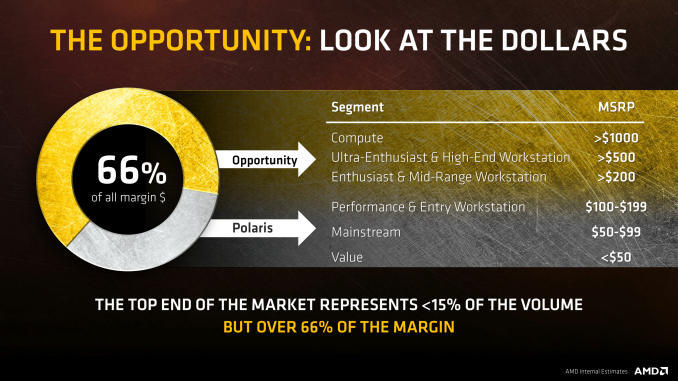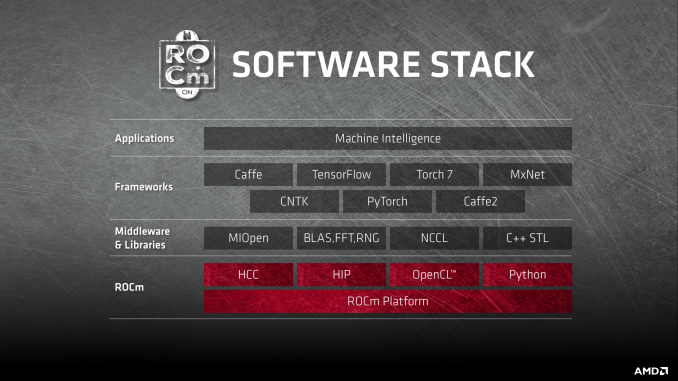AMD Unveils the Radeon Vega Frontier Edition: Vega Starts in the Pros
by Ryan Smith on May 17, 2017 2:45 AM EST- Posted in
- GPUs
- AMD
- Radeon
- Machine Learning
- Vega
- Radeon Pro
- Vega Frontier Edition
Vega Frontier Edition’s Target Market: AI, Machine Learning, and other Professionals
As important as the Vega hardware itself is, for AMD the target market for the hardware is equally important if not more. Vega’s the first new high-end GPU from the company in two years, and it comes at a time when GPU sales are booming.
Advances in machine learning have made GPUs the hottest computational peripheral since the x87 floating point co-processor, and unfortunately for AMD, they’ve largely missed the boat on this. Competitor NVIDIA has vastly grown their datacenter business over just the last year on the back of machine learning, thanks in large part to the task-optimized capabilities of the Pascal architecture. And most importantly of all, these machine learning accelerators have been highly profitable, fetching high margins even when the cards are readily available.
For AMD then, Vega is their chance to finally break into the machine learning market in a big way. The GPU isn’t just a high-end competitor, but it offers high performance FP16 and INT8 modes that earlier AMD GPU architectures lacked, and those modes are in turn immensely beneficial to machine learning performance. As a result, for the Vega Frontier Edition launch, AMD is taking a page from the NVIDIA playbook: rather than starting off the Vega generation with consumer cards, they’re going to launch with professional cards for the workstation market.
To be sure, the Radeon Vega Frontier Edition is not officially branded as a Pro or WX series card. But in terms of AMD’s target market, it’s unambiguously a professional card. The product page is hosted on the pro graphics section of AMD’s website, the marketing material is all about professional uses, and AMD even goes so far as to tell gamers to hold off for cheaper gaming cards later on in their official blog post. Consequently the Vega FE is about the closest analogue AMD has to NVIDIA’s Titan series cards, which although are gaming capable, in the last generation they have become almost exclusively professional focused.
AMD launching a new GPU architecture in the professional space first is a very big deal. Simply put, the company has never done it before. Fiji, Hawaii, Tahiti, Cayman, Cypress, and more all launched in consumer cards first. The traditional wisdom here is that launching in the consumer space first allows consumers to get their hands on the cards now, while professional products undergo further validation and refinement to meet the higher standards of professional users. Put another way, consumers serve as the final layer of debugging a new GPU, offering mass testing unlike anything else. So for AMD to launch in the pro market first indicates that they have an extensive amount of faith in the product.
As for why AMD would want to do this, the following AMD slide says it all.
Simply put, professional cards sell for higher prices than consumer gaming cards, sometimes significantly higher. As a result it makes all the sense in the world to sell their first Vega cards to professional users who are willing to pay $1000+ for a compute card, as opposed to consumers who would like to pay half that. More than anything else, AMD’s overall lack of profitability has come from a lack of high-margin parts to help offset their ongoing operational costs, and launching Vega as a pro card is one of the steps AMD is taking to correct that.
For pro users then with sufficiently deep pockets, they’ll be the first to get a crack at AMD’s latest high-end video card/accelerator. AMD calls this line of cards the Frontier Edition, and while the name is clearly AMD being cheeky towards NVIDIA’s Founder’s Edition line, the analogy isn’t completely off-base. AMD’s target market is going to be machine learning developers, game developers, and others who AMD believes need early access to the cards for future development. The advantage of this route is that, particularly in the case of machine learning, this allows developers to get a jump on testing a new architecture ahead of placing a large order for server cards. So in a sense, one of the roles of the Vega FE is to prime the pump for selling Radeon Instinct MI25 cards later in the year.
As for consumers, while this is as big a change for them as it is for AMD, it’s likely a hallmark of what to expect in the future for new high-end GPU launches. For AMD gamers who have been holding out for Vega, it’s clear that they’ll have to hold out a bit longer. AMD is developing traditional consumer gaming cards as well, but by asking gamers to hold off a little while longer when the Vega FE already isn’t launching until late June, AMD is signaling that we shouldn’t be expecting consumer cards until the second half of the year.
Wrapping things up, it’ll be very interesting to see how this strategy goes for AMD. NVIDIA has been very successful in the machine learning market over the last year, and if AMD can replicate NVIDIA’s success, not only will they make the machine learning market far more competitive for everyone, but they also stand a very good chance of finally turning the corner on both profitability and their overall share of the HPC market.













134 Comments
View All Comments
Yojimbo - Thursday, May 18, 2017 - link
"Nobody outside the DOE will be buying V100s this year."According to NVIDIA's presentation that isn't true. They say that the DGX-1V is supposed to start shipping in Q3 and that third party servers will ship in Q4. Hyperscalers will probably start to get them at the same time DGX-1V shipments start or even earlier.
JKay6969AT - Wednesday, May 17, 2017 - link
And they also forgot to mention that nVidia just let Volta out of the bag for, yup, you guessed it, the Pro market. Volta with it's 16GB of HBM2 memory with 896Gbps bandwidth, 5120 CUDA cores and 640 TENSOR Cores makes even VEGA look old tech in comparison (For the Pro Machine Learning market). I just hope for AMD's sake that either VEGA can compete with Volta, Volta is targeting a different sector of the market than VEGA or that AMD is willing to take a bigger hit to the margins with VEGA to stay competitive.Volta on the desktop I imagine will...
Not have the TENSOR cores as they seem to be optimized for machine learning tasks (that's my understanding of them anyways)
Not come with 16GB of HBM2, more likely 8GB or 12GB+ of GDDR5X or 6. Premium models may offer 16GB HBM2 like the Titan Xv but the 2080 Ti will most likely come with 12GB+ GDDR5X or 6 depending on when it launches.
Not offer 896Gbps bandwidth due to only having 8GB HBM2 it will offer 480~Gbps like the VEGA counterpart.
This makes desktop VEGA and VOLTA potentially much closer in performance than the Pro versions meaning that AMD should be able to compete for some of the desktop market.
Currently Volta costs $18000 USD for a single board, this gives AMD a fair amount of wiggle room on competing price :-) lol
However I must say I am impressed with what nVidia has shown with Volta, even though I would never need such a product, I am impressed with the advancements they have made and the sheer size of the GPU is incredible, however it could be telling that nVidia NEEDED all that die space to get the performance boost, could Volta be less efficient than hoped? I don't know, it's still impressive.
lmcd - Wednesday, May 17, 2017 - link
Any more buzzwords to capitalize here?rarson - Wednesday, May 17, 2017 - link
Tensor cores are there to compete with Google.tuxRoller - Wednesday, May 17, 2017 - link
That's an interesting use of the word "compete".Ryan Smith - Wednesday, May 17, 2017 - link
As a rule of thumb, we don't publish competitive performance slides. While I doubt AMD is lying, it's not something we can verify at this time, and in these cases vendors usually cherry-pick at a minimum.jjj - Wednesday, May 17, 2017 - link
You seem to be jumping to the conclusion that this is the first Vega to launch and consumer comes later but don't quite think that AMD has stated that. Yesterday's event wasn't the right place to launch consumer products but that doesn't mean there won't be consumer Vega before this one. The 16GB of HBM makes it even less likely for this one to be the first to ship.You also seem to miss that this is not Vega Instinct , it's a Pro card but seems that it's a kind of high volume sampling SKU so AMD is either not quite ready on the software side or can't make all that many yet , for high volume deployment in data centers.
BTW AMD lists 25TFLOPS FP16 not 26, so base clocks and they likely have a reason to do so.
As for all the preaching about prices and higher margins, that's false and hugely misleading. Higher margins and ASPs sure but much lower volumes and substantial investments in both hardware and software. The high end gaming is plenty profitable, if the product is good enough to sell because sites like this one are promoting ridiculously priced GPUs instead of urging users to never buy such poor value products. It's Trumpian that hardware sites are not making fun of such terrible value products instead of trying really hard to sell them. The press today serves the corporations not the consumer- wasn't like this just a few years ago. You are actively working hard to make people dumber and waste their money every time you don't just laugh at a 500$ GPU or a 700$ phone. Anyway, this is not 10 years ago when the Pro cards were so much more profitable and it's because the press is utterly corrupted and made the consumer much much stupider. Today high end gaming funds the pro and server cards and only in the next few years ,when the deep learning market grows to a sufficient size, it will be able to fully fund the product development, but only for the market leaders.
Yojimbo - Wednesday, May 17, 2017 - link
There was no reason for AMD to not launch a consumer card yesterday. It wasn't a developer's conference. It was an investor's day event. Investors don't care if a product is a consumer product or a professional product. They just want profitable products, and they'd like to hear about as much as possible.I don't remember the exact quote, but from what I remember Raja Koduri said things like "There's been a lot of rumors. Everybody's asking where's Vega? When will it appear? Well today we can say the first Vega will be released at the end of June, called Vega Frontier." His quote did make it sound like no consumer Vega would be coming before Vega Frontier. Whether a consumer Vega will be appearing alongside Vega Frontier is less clear, but the situation suggests to me that it will not.
Meteor2 - Wednesday, May 17, 2017 - link
Yes that's a bit worrying. I was expecting something consumer at Computex or a special event in June.rarson - Wednesday, May 17, 2017 - link
http://pro.radeon.com/en-us/vega-frontier-edition/"if gaming is your primary reason for buying a GPU, I’d suggest waiting just a little while longer for the lower-priced, gaming-optimized Radeon RX Vega graphics card."
They outright stated consumer Vega is not coming first. And then put it in print as well.